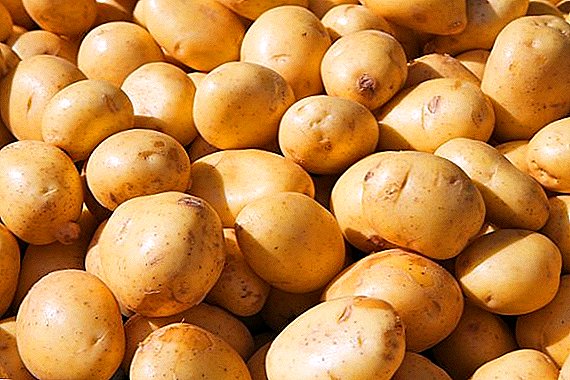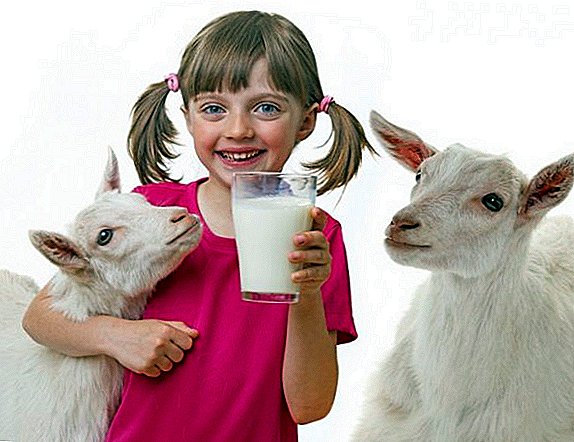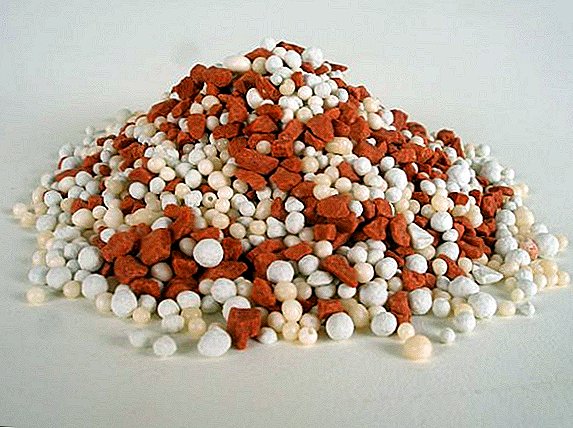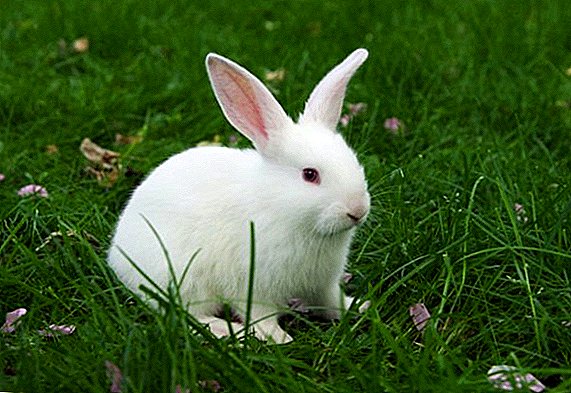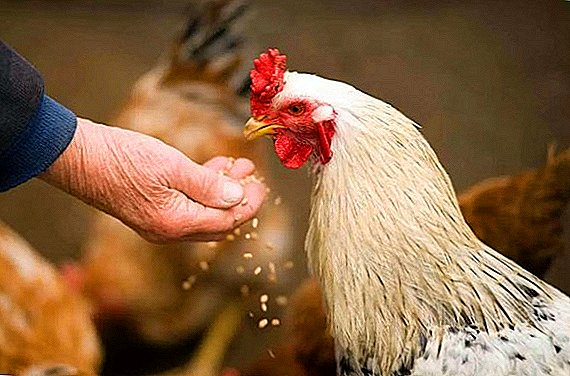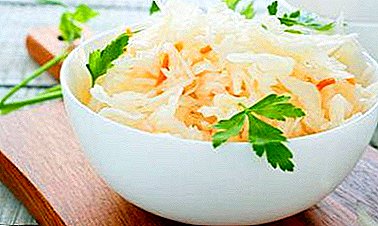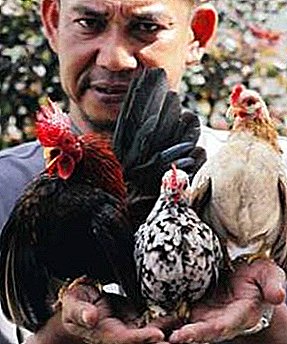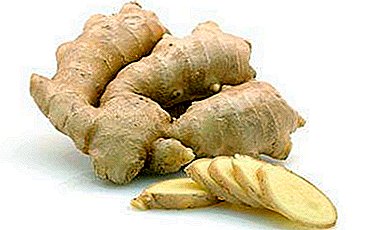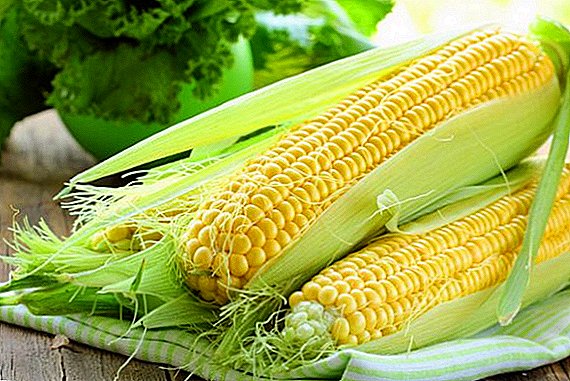 Corn, which is also called maize, is a valuable raw material for the production of food and feed for livestock. It is actively used in industry, medicine and cosmetology. About its composition, valuable qualities, features of use and storage and will be discussed.
Corn, which is also called maize, is a valuable raw material for the production of food and feed for livestock. It is actively used in industry, medicine and cosmetology. About its composition, valuable qualities, features of use and storage and will be discussed.
Chemical composition
Corn is a herbaceous plant, reaching four meters in height and extending to the ground by one and a half meters. It contains all the necessary substances that accumulate in the leaves and cobs.
Therefore, the chemical composition of corn is wide and diverse: it has about ten vitamins, including all the most important of group B, as well as C, E, PP, K and beta-carotene.
Did you know? Corn a few thousand years ago in present-day Mexico, corn initially had very small ears, not exceeding four centimeters in length.

It contains both micro and macro elements in the form:
- potassium;
- copper;
- gland;
- phosphorus;
- Selena;
- calcium;
- zinc;
- sodium;
- manganese;
- magnesium.
Corn also contains valuable omega-6 and omega-3 fatty acids.
Find out which corn varieties are best for making popcorn.
Calorie content
It is impossible to determine the exact amount of calories contained in hundred grams, as is usually done with other products in corn: here everything depends on the type of corn kernels and the method of their preparation.  Raw grains have a caloric content of 99 kilocalories per 100 grams, canned contain 103 kilocalories, and dried grains contain as much as 335 kilocalories. If you take, for example, popular popcorn, then in a hundred grams it is already 408 kilocalories.
Raw grains have a caloric content of 99 kilocalories per 100 grams, canned contain 103 kilocalories, and dried grains contain as much as 335 kilocalories. If you take, for example, popular popcorn, then in a hundred grams it is already 408 kilocalories.
The energy value
Corn kernels are saturated with proteins and fats and carbohydrates. In addition, they contain fiber, dextrins and starch, as well as mono - and disaccharides.
Did you know? Corn contains about 30 elements of the periodic table, and most of them are preserved after heat treatment.
While proteins and fats are practically the same in the energy plan in corn kernels - 15% and 14% respectively, the carbohydrates in this product have several times higher energy value. 
Beneficial features
The saturation of maize grains with valuable substances predetermines the greater usefulness of this product for human health.
The composition is so well balanced in the product, that with its regular use in food, the human immune system is significantly strengthened and confidently resists colds and infectious diseases.
The presence of nutrients in the form of maize, sodium, and sodium has a beneficial effect on the state of the cardiovascular system, protecting a person who loves corn dishes from a heart attack, stroke, and other cardiological problems.
The sucker silver, colza, hellebore, lavender, mountain arnica, oregano, chervil, caraway, rocambol, cantaloupe, hops, oxalis, calendula and buttercups have a beneficial effect on the cardiovascular system.
The large antioxidant potential of the product inhibits the aging of tissues in the body, cleans blood vessels and even prevents the onset of cancer problems. Regular consumption of corn can optimize the functions of the visual apparatus: the carotenoids present in it increase visual acuity.
Regular consumption of corn can optimize the functions of the visual apparatus: the carotenoids present in it increase visual acuity.
Saturation of the representatives of the vitamin B group allows corn products to positively influence the state of the human nervous system, suppressing irritability, neurosis, and overcoming depression and the effects of stressful situations.
Another interesting and, undoubtedly, valuable quality of corn grains: the elements contained in it are able to neutralize the harmful effects of alcohol. The presence of vitamin K improves the ability of the blood to clot quickly, and glutamic acid activates the brain and improves memory.
The presence in the corn cobs of fiber activates the secretory and contractile functions of the gastrointestinal tract, stimulating the rapid excretion of toxins and poisons. 
Special properties of consumed products
Many methods of cooking corn kernels and the abundance of products from them predetermine the variety of useful properties inherent in them.
Corn Oil Benefits
This oil is not made from corn grains themselves, but from their germs, and it is very high in calories - 889 kilocalories per 100 grams of product. It contains all the same beneficial substances as in the grains themselves, but in a concentrated form. Therefore, the oil is even more useful for consumers.
It is indicated in diabetes mellitus, in case of problems with the gastrointestinal tract, liver and cardiovascular system, while preventing the occurrence of blood clots in blood vessels. A special role of corn oil, as well as corn on the cob, plays in strengthening the human immune system.  The advantage of oil is that it can be taken not only inside, but also externally. It is able to positively affect the hair and nails, strengthening them, and also contributes to a more rapid and successful healing of wounds on the skin and its rejuvenation.
The advantage of oil is that it can be taken not only inside, but also externally. It is able to positively affect the hair and nails, strengthening them, and also contributes to a more rapid and successful healing of wounds on the skin and its rejuvenation.
Did you know? Corn is the only cereal crop that has pure gold in its composition.
The benefits of canned corn
Canned corn is not only tasty, but extremely useful. Like the original product, it is very helpful in strengthening human immunity, and in addition, it successfully optimizes the activity of the nervous, cardiovascular and urinary systems.
Reducing the level of bad cholesterol in the blood, canned corn helps to clean the vessels and thereby prevents the development of atherosclerosis. It is important the value of this product in the regulation of glucose in the blood, as well as in losing weight. 
The benefits of cooked corn
Like other types of this product, boiled corn has a beneficial effect on the human immune system, reduces the content of "bad" cholesterol, strengthens the circulatory system, optimizes the functions of the intestines, exhibits choleretic and diuretic properties and contributes to the fight against edema.
The Use of Corn Porridge
Corn porridge, being an antioxidant, inhibits the harmful activity of free radicals, improves immunity, the state of blood vessels and the general well-being of the body.
The abundance of fiber in porridge perfectly stimulates the cleaning of the intestines from toxins and toxins and inhibits the development of putrefactive processes. Vegetable protein in porridge is almost completely absorbed by the body, supplying it with energy, but not accumulating excess fat in it.
Tibetan lofant, white mar, dried bananas, home fern, lagenaria, spinach, broccoli, amaranth, horseradish, Chinese cabbage, nectarines, plums and tomatoes will help remove toxins and toxins from the body.

Why is corn useful for the body?
The fruits of this wonderful plant are useful, with rare exceptions, to almost all people. But the diversity of substances within them implies some differentiation in the use of the product by people depending on their age and gender.
For men
Maize products are of particular value for men because of their ability to maintain potency at the proper level. In addition, they are involved in the prevention of male infertility, dysfunction and other pathological conditions of the male genital organs.
For the representatives of the stronger sex, engaged in hard physical labor, the ability of the fruits of this plant is useful, being fully assimilated, to qualitatively replenish the energy consumed by the body.
For women
The fruits of the “Queen of the Fields” are even more useful for women. They optimize the functioning of the female reproductive system, as well as soften the flow of critical days and menopause.  For pregnant women, the enormous potential of the substances contained in this cereal is useful both for its own organism and for the successful development of the fetus. Also important is the ability of corn products to fight edema.
For pregnant women, the enormous potential of the substances contained in this cereal is useful both for its own organism and for the successful development of the fetus. Also important is the ability of corn products to fight edema.
This grass is capable to help in one more extremely important sphere for women - in preservation of a slim figure and external beauty. This helps the dietary properties of the product, contributing to weight loss, as well as a set of vitamins of group B, which rejuvenates the skin and keeps it in tone, and the hair makes it lush and shiny.
For kids
The developing body of a child a huge stock of useful substances contained in maize, is very useful. He is shown literally all the dishes from this wonderful cereal. At the age of 8-9 months, babies are recommended to introduce corn porridge after rice and buckwheat in the form of complementary foods for the first time.
And boiled kernels can be given to children from the age of three. Corn sticks and flakes are very popular with children, but they have less benefit than natural maize dishes. 
Important! It is recommended to give children corn flakes not for breakfast, but between meals during the day with yogurt or kefir.
For people in age
The ability of food from corn to improve the body's immunity is very relevant for the elderly. And the antioxidant potential of maize, inhibiting the aging of the body and stimulating the regeneration ability of cells, for people of old age is simply irreplaceable.
It allows you to slow down the development of atherosclerosis and memory impairment. The ability of products from this cereal to improve eyesight is very important due to the presence of vitamin A in it.
Application in different areas
One of the most remarkable properties of corn is its versatility: it is good in food, in demand in cosmetology, and is actively used in medicine. 
In cooking
When cooking, most often because of its year-round availability, canned corn is used. It is used in the preparation of a variety of salads, side dishes and other dishes.
Corn and flour are also produced from maize, which are also widely used for making cereals and baking bread and other pastries. Specially grown small cobs are tasty, marinated in the same way as gherkins. Also made of maize famous popcorn.
Americans make their famous whiskey from corn, which they call bourbon. Nowadays, corn oil is becoming more and more popular, which is second only to olive oil and partly soy oil.
In medicine
Such a useful plant, of course, could not remain without attention from the healers. In folk medicine, corn is used in the treatment of glaucoma, and in the fight against obesity, pancreatitis and urolithiasis.
Traditional healers of corn silk are widely used, with which they treat jaundice, liver and kidney diseases, women's diseases and congestive edema.  Some curative properties of maize are used by representatives of official medicine: they prescribe corn stigmas extracts or tinctures as choleretic agents, as well as to give blood the ability to coagulate better.
Some curative properties of maize are used by representatives of official medicine: they prescribe corn stigmas extracts or tinctures as choleretic agents, as well as to give blood the ability to coagulate better.
And especially popular in official medicine is corn oil, which has confirmed its capabilities in the fight against atherosclerosis and "bad" cholesterol in the blood vessels.
In cosmetology
Mais uses the location of cosmetologists mainly due to the presence of vitamins K and E in it, which have a vital effect on hair, skin and nails.
We advise you to read about how to use nettle, rosemary, marjoram, bird cherry, nasturtium, sedge, coltsfoot, calendula, enoteru, soapworm, comfrey, marigold, elder, savory and parsnip for cosmetic purposes.
Corn oil successfully fights dry skin, which stops the peeling process and, by regenerating cells, gives the skin elasticity and firmness, while smoothing wrinkles.  Maize starch is used in the care of combination and oily skin, not only absorbing sebum as an absorbent, but also nourishing and protecting the skin. This type of starch is also involved in the production of baby powders and talc.
Maize starch is used in the care of combination and oily skin, not only absorbing sebum as an absorbent, but also nourishing and protecting the skin. This type of starch is also involved in the production of baby powders and talc.
The importance of nutrients contained in corn is evidenced by the fact that they are actively used in the manufacture of expensive cosmetics of the best brands.
In production
In many regions of the world, maize is among the main fodder crops for livestock, because even where conditions are unsuitable for its growth and maturation, for example, in Siberia, it is perfectly suited as green fodder and silage. And where conditions are favorable for corn, its yield reaches 10 tons per hectare.
In addition to grain, leaves, stalks, and cobs of corn are used for livestock feed, as well as what remains in the production of starch and butter. It takes maize and leading places in the processing industry, where it has long been one of the main raw materials for the production of edible oil, starch and gluten. Flakes, flour, cereals and popcorn are also produced from this plant.  Corn starch is used to make paper, cardboard, paints, detergents, glue, cosmetics, diapers, agrochemicals and more and more plastic bags that are used, which have the ability to decompose and not litter the environment.
Corn starch is used to make paper, cardboard, paints, detergents, glue, cosmetics, diapers, agrochemicals and more and more plastic bags that are used, which have the ability to decompose and not litter the environment.
Maize is also widely used in the world in the production of alcohol for motor fuels - ethanol. In the United States, for example, up to forty percent of the entire corn crop is used for this purpose. From one ton of it get up to five hundred liters of bioethanol.
And in Europe they actively use this plant for biogas production. When growing special varieties, up to six thousand cubic meters of gas per hectare can be produced.
Contraindications and harm
There are people with individual intolerance to corn. For example, it is forbidden to take dishes from it to people suffering from a stomach ulcer and duodenal ulcer, in the period of exacerbation of the disease.  Since maize products have the property of improving blood coagulability, people who already have this coagulability should be avoided. Women who breast feed babies should not abuse corn, as this can cause colic and flatulence in an infant.
Since maize products have the property of improving blood coagulability, people who already have this coagulability should be avoided. Women who breast feed babies should not abuse corn, as this can cause colic and flatulence in an infant.
Important! Excessive use of corn can lead to abnormal stools and bloating even in adults.
How to cook to save vitamins
During heat treatment, corn loses less nutrients than other cereals, but still there are cooking rules for it that allow you to minimize the loss of vitamins and other valuable components.
Boil the cob should be in a container sufficient to ensure that they all fit in it freely. It is recommended to lay out the bottom and sides of the pan with part of the leaves taken from the cobs, and add a few antennae there. Then you should put the cob in the pot, cover them with the rest of the leaves and pour water a little higher than their level. Putting the pot on the fire, always cover it with a lid.
Storage conditions
Although maize does not belong to perishable products, it cannot store its useful nutritional and healing qualities on the cob for a long time. Therefore, there are various ways to preserve the product in its different states.
Familiarize yourself with carrot, onion, tomato, red cabbage, garlic, pumpkin, apple, cucumber, and potato storage methods.
About ten days, you can save the cobs in the freezer, pre-sealed them in plastic bags.
And if you pre-soak the cobs for twenty minutes in an ice-cold solution of water, lemon juice and salt, separate the kernels from the stalks and put them in tight-fitting plastic bags, they will be perfectly preserved in the freezer for about three weeks.  You can boil the cobs for ten minutes in water, cool them and remove the seeds from them, which should be poured into sterile jars and filled with boiling water with salt. In the refrigerator such product can stand for three months.
You can boil the cobs for ten minutes in water, cool them and remove the seeds from them, which should be poured into sterile jars and filled with boiling water with salt. In the refrigerator such product can stand for three months.
And if the well-peeled cobs are lowered for several minutes first into boiling water and then immediately into very cold water, their shelf life in the freezer will significantly increase.
Such a wonderful plant, like corn, in various forms can be found everywhere: on the table of a person, and in the trough of an animal, and in the fuel tank of a car, and in industrial production, and in cosmetology, and in medicinal drugs of traditional healers. Today this product is almost indispensable in many areas of human life.


